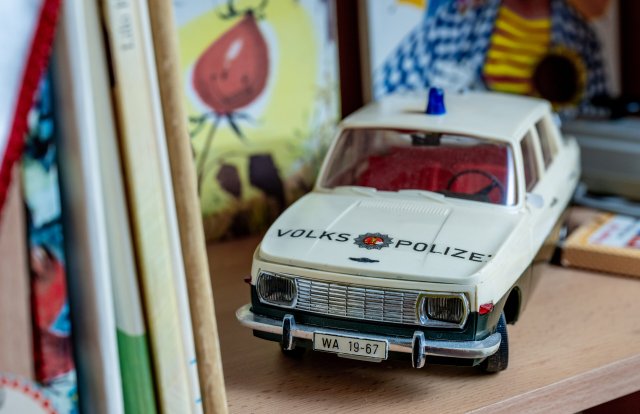A remote-controlled model Wartburg of the People’s Police in a GDR children’s room in the museum in Auerbach.
Foto: dpa/picture alliance
It is hardly visible in the cityscape that Berlin was a divided city for decades. Where a three-meter-high concrete wall once divided streets and squares, new districts have now emerged. Where the Wall divided families and work routes, a generation of Berliners is now growing up with completely new opportunities. And the Berlin police force was also divided by the wall. With reunification on October 3, 1990, the People’s Police of the GDR and the police of West Berlin merged to form one police force. Today the Berlin police are a modern capital police force, diverse and colorful, just like the city.
The fate of the divided city of Berlin has also given its police a unique history. (…)
But what the reunification of the two police forces looked like on a small scale remained unnoticed for a long time. This raises very exciting questions: What did the police forces experience on both sides of the wall? Did they even perceive the same incident from different perspectives? What was it actually like to live in everyday police life with all the absurdities that the Wall created?
How did one imagine this in everyday life when these police officers met for the first time? At the station, in the radio van, in the administrative and administrative offices? And how did the merger of the two police forces possibly shape the self-image of our capital police?
nd.Kompakt – our daily newsletter

Our daily newsletter nd.Compact brings order to the news madness. Every day you will receive an overview of the most exciting stories from the world editorial staff. Get your free subscription here.
Until 2020, the experiences and experiences lay dormant in the biographies of the police officers. They were certainly a topic of conversation among close colleagues or family. Then the Berlin police officer Ute Kähler dedicated herself to this micro-history and opened it up to the public. In addition to a remarkable video project on the reunification of the two Berlin police forces, which is available on the Internet, there is now this moving book entitled “On Both Sides – The Berlin Police at the Wall. Stories” were created. It provides an insight into everyday police life a few years before the fall of the Berlin Wall – in East and West. Lively and of great authenticity.
Based on police section 15, in the middle of Prenzlauer Berg with Bornholmer Bridge, Mauerpark and Gethsemane Church, the police officer and author travels on historically significant terrain every day and works side by side with colleagues who spend the time “on both sides” of the Wall experienced. Out of personal interest, she went looking for clues 30 years after reunification. She also wanted to secure the experience for future generations of police before the service personnel from back then go into deserved retirement or die unexpectedly, like our colleague Herbert Falk, who Ute Kähler interviewed for the book and who died under tragic circumstances in the line of duty in 2021 Life came.
Ute Novakovic managed to find access to her colleagues. She is one of them, with an Eastern biography (which is why she writes under her maiden name), bold and deeply empathetic at the same time. She simply asked questions, listened and gained trust in this way. First one colleague said this, then another, and there were more and more. Three important things can be felt in their stories: respect, great closeness and an even greater sympathy for their colleagues, regardless of whether they are still active or already retired. (…) Above all, it becomes clear that it is not the one There is a story about the police during the time of the Wall. Only all the stories together create a multi-faceted picture of the living and working world at that time directly on the state border (as it was called in the GDR) or the demarcation line (as it was said in West Berlin). (…) The stories are also an expression of recognition for the colleagues who had to completely reorient themselves in the police profession after the fall of the Berlin Wall. And not all members of the People’s Police were transferred to the Berlin police force. Here too, the stories paint a differentiated picture.
From the foreword by Barbara Slowik, police chief in Berlin, to the book by Ute Kähler “On Both Sides” (Verlag am Park, 160 pp., br., 20 €); Reading and conversation with the author on April 25th, at the “Rendezvous” in Hellen Panke, Kopenhagener Str. 9, 10437 Berlin, 3 p.m.
Become a member of the nd.Genossenschaft!
Since January 1, 2022, the »nd« will be published as an independent left-wing newspaper owned by the staff and readers. Be there and support media diversity and visible left-wing positions as a cooperative member. Fill out the membership form now.
More information on www.dasnd.de/genossenschaft
